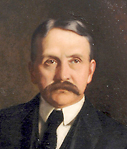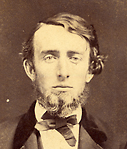The president who created a lasting blueprint for excellence in U-M’s formative years wasn’t always celebrated in his time.

A new exhibit commemorates Henry Tappan’s far-reaching impact. All photos courtesy Bentley Historical Library
Henry Tappan, a philosopher and pastor from New York, was appointed president in 1852. In a sweeping inaugural address, he urged the advancement of knowledge in every field — from the most esoteric to the most practical.
But after serving 11 years, Tappan was fired by the Board of Regents in 1863. Some felt he moved too fast and was a bit overbearing and intolerant. Still, no president had more impact on the course of U-M, or did more to ensure success, says Francis Blouin, director of the Bentley Historical Library.
Blouin also is curator of the new semi-permanent exhibit Tappan’s Vision, presented from 1-5 p.m. Monday through Friday in the library’s Whiting Room. The exhibit is presented as the Bentley Library celebrates its 75th anniversary.
“Tappan set in motion an extraordinary dynamic. He had a comprehensive view of higher education and that’s what the exhibit gets at,” Blouin says.
Key to that dynamic was Tappan’s vision to hire innovative scholars in a range of disciplines. Through photographs and a series of text panels, Tappan’s Vision profiles several pioneering thinkers drawn to U-M by the aesthetic Tappan created, and the visionary faculty who followed.
In Tappan’s inaugural address, he said a great university could be, “a splendid beneficence, a monument worthy of the ambition of any man, or of any number of men who would lay the foundation and cornerstones thereof.”
“Tappan was ahead of his time in many ways. He recognized the importance of education for women. He was a tireless proponent of strong schools at all levels so as to ensure the best students would be prepared for his university,” Blouin says. “What is interesting in this speech is it was so far thinking it took decade after decade for the university to achieve the fulfillment of the vision. He set the university on a very ambitious course.”



Adams
Crosby
White
Blouin says Tappan’s greatest achievement to promote the sciences was the establishment of the U-M Detroit Observatory in 1854. He followed this by in 1857 hiring Andrew Dickson White, who later would become founding president of Cornell University. The exhibit presents part of a history lecture White developed in Ann Arbor, in which he states that scientific investigation free of religious interference “has invariably resulted in the highest good of religion and of science.”
In 1853 Tappan hired natural history scholar Alexander Winchell, whose deepening study of geology persuaded him the earth was far older than a conventional understanding of the Bible implied.
Charles Kendall Adams — who earned his bachelor’s and Master of Arts degrees from U-M during Tappan’s time as president, and then was hired as professor of history and Latin — established a new department of political science within LSA. This made Michigan a leader in the emergence of political science as an independent discipline. Adams, like his mentor White, also would go on to serve as Cornell University president.
Scholars who succeeded them include John Dewey (1859-1952) — a founder of pragmatism and functional psychology, considered the bedrock ideas of modern social science — who asserted that fully realized democracy would rest not only on the extension of voting rights but on well-informed public opinion; James Burrill Angell, U-M’s longest serving president who in the late 19th century had the vision to create strong and permanent ties between the university and China; and Harold Cruse, one of the most influential and controversial African-American authors and thinkers of the 1960s and an early director of Michigan’s Center for African and African American Studies.
The exhibit also celebrates more recent intellectual innovations such as the establishment of the Institute for Social Research, where researchers performed innovative studies on an array of topics under the leadership of Angus Campbell and Rensis Likert; Arthur Burks, who helped to create one of the nation’s first academic programs in computing; and Elizabeth Caroline Crosby, whose studies to map the structure of the brain were distilled into a textbook that remained the standard reference on neuroanatomy for decades.
After U-M, Tappan and his family lived in Berlin, Germany, and elsewhere in Europe. Blouin says the university invited Tappan to attend the 1875 commencement and resolved to erase from the university’s history all criticism of his leadership. He declined, saying, “A compliment does not repair a wrong.”
Tappan continued to write and speak on education but never took a formal position with a university. He died in 1881 in Switzerland.

